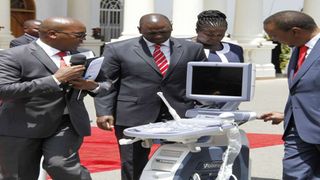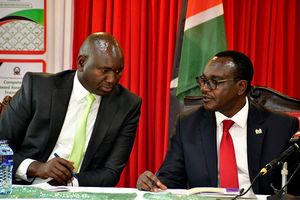
President Uhuru Kenyatta (2nd right) and DP William Ruto are shown how an ICU machine works by former Director of Medical Services Nicholas Muraguri during the signing of contracts for the Managed Equipment Service (MES) on February 6, 2015.
| File | Nation Media GroupNews
Premium
Sh63bn MES heist: How ‘Mafya cartels’ executed theft of public funds
What you need to know:
- This group would go ahead to execute a plan that forced counties to lease medical equipment at an inflated cost of Sh200 million a year.
- First, it was decided the project will be initiated as a public-private partnership to escape procurement scrutiny.
- Mr Muchere paints a picture of how the suspect deals were planned and executed.
One morning in 2014, a powerful cabal at the Ministry of Health sat down at the headquarters in Afya House, Nairobi.
It was slightly more than a year into the Jubilee administration, and everyone was still excited at what lay ahead under the new devolved system of government.
The team plotted how to beat Kenya’s stringent procurement laws and commit taxpayers’ Sh63 billion in a project a Senate committee has since branded a criminal enterprise.
And they succeeded. This group would go ahead to execute a plan that forced counties to lease medical equipment at an inflated cost of Sh200 million a year, for what should have cost Sh31 million.
The results of their exploits would erupt more than six years later, as some counties continue to pay for machines they have never used because they could either not install them, do not have electricity to run them, do not know how to operate them or do not have the space to place them — in a scandal that has left in its wake cheated taxpayers and county bosses scratching their heads.
Public-private partnership
First, it was decided the project will be initiated as a public-private partnership (PPP) to escape procurement scrutiny that comes with open tenders. By this decision, the tenderpreneurs also avoided the requirement that funds must be set aside in a budget before procurement is started.
As soon as the project was approved, they quickly abandoned the PPP path and started an international open tender.
The tenders were then crafted in such a way that a select number of local companies were looped in through the backdoor as subcontractors of allegedly original manufacturers. The subcontractors would immediately start operating as if they were the main contractors.
To ensure devolved units pay, the funds were provided through the ministry’s accounts at Afya House, but christened conditional grants to county governments to enable withdrawal at source from county revenue allocation.
That was before the cover-up started. Then-Principal Secretary Nicholas Muraguri had been accused in the Senate report of hiding the contract documents, claiming they were ‘secret’. Dr Muraguri served as the PS between 2015 and 2017.

President Uhuru Kenyatta (2nd right) and DP William Ruto are shown how an ICU machine works by former Director of Medical Services Nicholas Muraguri during the signing of contracts for the Managed Equipment Service (MES) on February 6, 2015.
Amount spent not clear
The exact amount spent on the contracts is not yet clear because ministry bosses submitted contradictory price lists of items to the Senate team.
Cabinet Secretary James Macharia, who was in charge of the health docket when the contracts were awarded, and Dr Muraguri, disowned an inflated price list submitted by his successor Sicily Kariuki, according to the parliamentary report. The two gave their own price lists to fight off claims prices were inflated. It would have been impossible to tell this story without the help of whistleblower Bernard Muchere, an internal auditor and anti-fraud expert who revealed the 2016 Afya House scandal.
In a detailed open letter to the Senate Ad-hoc Committee Investigating the Managed Equipment Services (MES) scandal, Mr Muchere paints a picture of how the suspect deals were planned and executed.
Original manufacturers
“The MES contracts were fraud ab initio (from the beginning). The fraud was schemed through initiation as PPP projects, after which the contracts were unlawfully converted into commercial contracts, shifting the financing responsibility from the managed equipment provider to GOK,” he states.
A retired internal auditor at the Treasury, Mr Muchere lifted the lid on how taxpayers could have lost Sh5 billion in theft akin to the one at the National Youth Service, where at least Sh791 million was lost in 2015.
Mr Muchere is now the executive director at Zerot Fraud Risk Management Consultants. He is also a former president of Certified Fraud Examiners, Kenya Chapter (134).
In the short period (June – December 2016) he was the head of internal audit at Afya House, he noted serious challenges in the management of the MES contracts.
His team was denied access to the contractual documents, which contained detailed information, confining them to scanty information on the payment documents.
The PPP subterfuge is the same way the Standard Gauge Railway tender was done.
Meet obligations
Both the Public Procurement and Disposal (PP&D) Act, 2005, and the Public Finance Management (PFM) Act, 2012, which are the bibles for procurement officials, bar commencing any procedure until sufficient funds have been set aside in the budget to meet the obligations of the resulting contract.
The procurement started shortly before June 2014. The ministry invited sealed bids from original equipment manufacturers from June 9, 2014. The Sh38 billion tender was awarded in February 2015.
The contracts involved supply, installation, testing, maintenance, repair, replacement, and associated training on equipment for theatre, Central Sterile Supply Department (CSSD), laboratory (Category 1), laboratory (Category 2), renal, ICU, and radiology to 94 county and sub county referral health establishments in all 47 counties.
Five consortiums won the tenders. Most of the lots were given to a global company that had a local subsidiary as a subcontractor.
The first lot went to Shenzhen Mindray Biomedical Electronics Co. (China) and subcontractor, Megascope Healthcare Ltd (Kenya).
The second lot went to Esteem Industries Inc. (India) and subcontractor, Debra Ltd (Kenya).
Bellco SRL from Italy who had Angelica Medical Supplies as a subcontractor got the next lot. Next was Philips Medical Systems Nederland BV, who got another lot working with Philips East Africa Ltd as its subcontractor, while the final lot went to GE East Africa Services Ltd.
No budget for MES project
When the contracts were being awarded, there was no budget for the MES project in the first three financial years — 2013/2014, 2014/2015 and 2015/2016.
To deal with the lack of budget, the Integrated Financial Management Information System (Ifmis) cashbook shows that payments were made under Hire of Equipment, Plant and Machinery account code No. 1081001701 – item 2210606 – rental of produced assets.
The forward budget estimates for the rentals of produced assets for the three years added up to Sh10.2 billion. This was still not enough to cover the Sh38 billion required, having fallen short by about Sh27.8 billion. At this point, the procurement department had already committed an economic crime, enough to land any procurement officer in jail.
It was not until the 2016/2017 financial year that the government provided a budget for the MES contracts. This was captured under account No. 1081104401 – Managed Equipment Service-Hire of Medical Equipment for 98 Hospital – 2210600 Rentals of Produced Asset.
Despite all the safeguards provided by the procurement laws in Kenya, the MES exploited the weaknesses in the system to have its way.
“These governance structures had the responsibilities to ensure that procurement of MES complied with the provision of the PPP Act 2013, but they absconded their responsibilities to assist the contracting authority, MOH, to abandon the PPP contracts and engage in unlawful commercial contracts that appeared to have committed economic crimes under section 45(2) of ACECA, 2003,” says Mr Muchere.
Managed equipment services are a flexible and specialised partnership with private sector service providers, to provide access to innovative medical technology and equipment. The purpose of inviting tenders from original equipment manufacturers was to access innovative medical technology and equipment direct from the makers.
Equipment subcontracted
But the first red flag was when the equipment was subcontracted, given that it was not clear what specialised work the subcontractors were to provide.
Records of payments shown in the Ifmis cashbook reveal that the MES contract might have been a fraud.
On August 21, 2015, Bellco Sri Ltd was paid Sh258.7 million. Auditors felt this was a fraud because the contracted company was Bellco SRL (Italy), but the payment was made to Bellco Sri Ltd.
“This raises a red flag on whether the company paid, and the company contracted were one and the same,” says Mr Muchere.
Another payment of Sh819.2 million happened on April 5, 2016 to GE East Africa Services Ltd. Auditors wondered whether the company was the original manufacturer.
In the same pattern, Mindray Medical Kenya Ltd was paid Sh157.5 million on behalf of Chinese firm Shenzhen Mindray Biomedical Electronics Company, the main contractor.
“This demonstrates that, the condition of inviting bids from the original manufacturers might have been a ploy to prevent other local firms from tendering for the contracts, enabling the schemers to direct the contracts to a few selected local firms,” explains the Muchere dossier.
One of the main reasons the procurement laws exist is to ensure Kenyans get value for money.
After abandoning the initial procurement plan through PPP and floating an international open tender in July 2014 that was restricted to original equipment manufacturers, something else needed to be done by the fraudsters.
Financial advisory services
Procurement through international open tender is guided by section 51 to 68 of the PP&D Act, 2005. There were no provisions within the sections for procurement of financial advisory services. Notwithstanding this limitation, the Ministry of Health went ahead to procure services from PKF Kenya and Spa Infosuv East Africa Ltd.
Mr Muchere says it is not clear whether the Sh9.6 million paid for financial advisory services was justifiable and lawful. Like the financial advisory services, legal advisers are not provided for under the procurement law. This raises a red flag as to whether procurement of the Iseme, Kamau and Maema Advocates at a cost of $560,000.00 (Sh60.4 million) was lawful.
The procurement law gives the responsibility of processing international tenders to the opening, evaluation and tenders committees.
It is clear from the provisions of the said sections that the financial advisers and legal transaction adviser are not provided for as party to the procurement process.
Value for money is measured by establishing realisation of five key parameters — economy, efficiency, effectiveness, environmental and equity.
The other challenge the fraudsters had was how to make sure counties pay for the equipment. To deal with this, Afya House sneaked the programme to be accounted for under the conditional grants, despite not meeting the criteria. This is what justified the deduction of the counties’ share of revenue at source.
By approving deduction of the counties’ share of revenue at source, the National Treasury and the controller of budget violated Article 219 of the Constitution.
The Public Finance Management Act does not provide for such direct deduction, neither does it provide how such deducted revenue is accounted for.
Respective counties have a right to claim the deducted amount.
To secure transparency and accountability, the approved budget estimates are categorised in terms of administrative, economic, and functional classifications. The budgetary classifications are integrated with the set of accounts represented by account codes.
The classifications identify the administration division responsible for budget management and the economic activity.
The administrative classification in all these accounts was the Ministry of Health headquarters. It was responsible for the expenditure and accountability of the budget estimates under these accounts.
The estimates were not conditional grants as claimed. Grants are budgeted for under title or accounts – 2630200, capital grants to government agencies and other levels of government.






